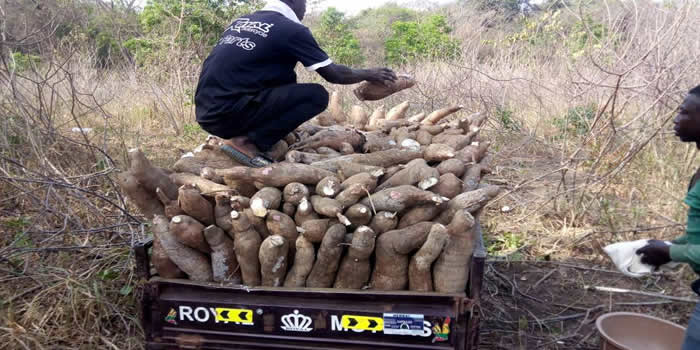

The dominant economic activity in employment in the Berekum Municipal is agriculture. It employs about 57 percent of the working population. It constitutes the major source of household income in the district. Production estimates for major crops in the Municipality show that the Municipal is performing below the national averages in terms of output per acre/hectare.
Despite the fact that majority of the working population are engaged in the agricultural sector, most of them are peasant or subsistent farmers who produce to feed themselves and their families and sell small amounts of their output to purchase non-food items like salt, soap, clothing etc. This assertion is supported by the fact that for the five major food crops considered; more than 50 percent of the total output is consumed except in the case of rice where as much as 66 percent of output realized is sold.
This due to the fact that about 90 percent of the Municipal population is Brongs (Akans) whose staple food does not include rice. And as it is the convention in Ghana, imported rice is believed to be superior to locally produced rice in terms of taste hence when rice is to be taken, the people go in for foreign rice. With subsistence farming dominating the agricultural sector, incomes from the sector is generally low in relation to farmers’ earnings. The output per farmer per hectare, the proportions sold, consumed and what go bad are shown in table 29: below.
The major food crops grown in the area are maize, cassava, yam, plantain, cocoyam and rice. Mention should also be made of vegetables like tomatoes, garden eggs, pepper, okro. With regard to cash or industrial crops, the major ones grown in the district are cocoa, coffee and oil palm.
Reliable data were not available but other cash crops like cashew, citrus, cola nut, Citronella and others are also grown in the district but on small The average farm size in the district is about 1.8 acres compared to 2 acres at the national level. About 62 percent of farmers in Berekum district rely on family land for farming.
Hence for large tracts of land for cocoa farming, many farmers go to the Sefwi area in the Western Region. With the Municipality population growing at 3.3 percent annually, land per head will continue to decrease which will affect farm sizes and for the that matter output levels.
The major farming practice is mixed cropping while continuous cropping and bush fallowing are the other two most common farming systems. However, with the bush fallowing, the lack of large tracts of land for farming has affected the fallowing period reducing it to one or two years.
As regards farming methods, majority of farmers in the district still rely on the traditional method, which uses the cutlass and hoe for clearing the bush and the cutlass for harvesting. A few go further to apply some insecticide and fertilizer after weeding and planting with the hoe and cutlass. This known as the inter-immediate method of farming. However, the local income levels make the application of insecticide and fertilizer a preserve of a few farmers.
Approximately 80 per cent of farmers in Berekum Municipal use hired labour, 18 per cent use family hands and 2 per cent “nnoboa” for their farming activities. Hired labour is use for cash crop and with the low incomes of the farmers as against the high cost of labour (about ¢25,000.00) on the average) for five hours of work done, that is between 8a.m. and 1 : 00 p.m. One major problem is unavailability of the labour most of the time. Sources of funds for farming activities are mainly from the farmer’s personal coffers (80 percent), 15 percent from moneylenders and financial institutions constituted a margin about 5 percent of the average loan/credit ¢200,000 each annually.
Closely related to the above is the fact that 42 percent of the farmers do not receive any assistance of any form from any agricultural supporting institution. These are the agricultural extension officers and the Agricultural Development Bank (A.D.B). Agric Extension Officers are accessible to 88 percent of farmers whilst only 16 percent have access to the A.D.B. Bank. However, with an Extension Officer –farmers ratio of 1:3000 as against 1:400 for the nation, the assistance farmers receive from the officers is insufficient.
Storage of farm produce is a problem for farmers in the district and about 75 percent make use of storerooms, 13 percent, kitchen and 10 percent store their produce in Silos. More than 90 percent of farm produce in the district is sold unprocessed. Farmers therefore are not in the position to store or process their produce in order to add value. They therefore sell produce at lower prices during bumper harvest. This eventually affects the income levels of the farmers. Out of the quantity sold, 87 percent is sold within the Berekum Municipal mostly at the major market Centre in the district that is located in Berekum and at times at Jinijini. The rest is sold in the various settlements where the farmers find themselves.
Farmers in Berekum Municipal like their counterparts in other parts of the country are faced with a number of problems. Among them are inadequate capital for farming, problems with land acquisition, problems with storage and marketing, declining soil fertility and high cost of inputs.
Percentage of Post Harvest Losses
The Percentage of Post Harvest losses for cereals decreased from a level of 25-30% in 2003 to 20-25% in 2004. There was a marked improvement of 28-30% in perishables in 2004 over 2003 figures of 30-35%.
This is due to the technologies being introduced to the farmers by the Agricculture Extension Agents (AEAs), and farmers .adoption of the use of storage facilities.Maize production increased in the 2005 because of the introduction of the Maize Production Project.
Extension Officer Farmer Ratio
The ratio of Extension Officer to the number of farmers decreased from 1:3000 in 2003 to 1:2800 in 2004. This is an indication that fewer farmers now have access to the same Extension Officer. But this is not an ideal situation. All things being equal this figure should be 1:1,000.
CIDA/FABS Support
The Ministry of Food and Agriculture utilized the CIDA/FABS fund to support an agro-processor with processing equipment to reduce post-harvest losses and add value to farm products. Details of the equipment bought are as follow:
- One (1) corn mill
- Twenty (20) solar dryers
- One (1) oven
Furthermore a Grass cutter Farmers Association has also been funded to reduce environmental degradation through bush burning and animal poisoning. In addition two (2) Pig Farmers Association were also supported with funds to expand and make available to the Municipal readily available protein at affordable prices.
The proportion of unemployment among persons aged 15 years and older for the Brong Ahafo Region (3.0 per cent) is about half the national average (5.4 per cent). Proportions of less than 1 per cent are recorded in Dormaa (0.1per cent). Berekum District recorded highest (6.1 per cent). There is therefore the need for the District to come up with pragmatic policies to reduce unemployment and underemployment in order to improve the quality of life of the people. The district should take advantage of the national Youth Employment Programe to expand job avenues.
Livestock Farming.
Animal rearing is a very important sub-sector in the agricultural sector in the Berekum Municipality . Sixty-one (61 percent) of animal farmers in the district practice commercial farming. Animals kept include poultry, sheep, cattle, goats, pigs etc. The perceived reduction in the pig population was due to the threat of the African Swine Fever. Poultry also suffered a significant reduction due to the acute shortage of maize to feed them during the early part of the year 2005.
Future Outlook
Undertake major land management practice in the district.
Conduct land suitability map to indicate soils(lands for specific crops)
Staff Accommodation
Senior Staff Quarters - Nil
Junior Staff Quarters - 4
All the 4 junior staff quarters are in a bad state.
Mobility
Motor Bikes – 4
Fixtures and fittings Inadequate
Development Projects
CIDA/FABS Funds to support and Promote FBOs
Maize Production Project
Coca Hi – Tech
Mushroom Production
Grass cutter Production
Use of Solar Driers to reduce Post Harvest loses especially in vegetables.
Use of improved Narrow Cribs to reduce Post Harvest loses in Maize.
Competitive / Comparable Advantage Of Major Crops Produced In The District
Plantain
Maize
Livestock
Pepper
Cassava
Plantain production has a comparable advantage over the other major crops produced in the Municipal. It is ranked highest due to the suitability of the climatic conditions for its production in the district. Maize, livestock and Pepper follow in that order. Livestock production has a comparative advantage due to the large volumes of foliage available all year round
Date Created : 11/15/2017 6:07:27 AM












 facebook
facebook
 twitter
twitter
 Youtube
Youtube
 +233 593 831 280
+233 593 831 280 0800 430 430
0800 430 430 GPS: GE-231-4383
GPS: GE-231-4383 info@ghanadistricts.com
info@ghanadistricts.com Box GP1044, Accra, Ghana
Box GP1044, Accra, Ghana